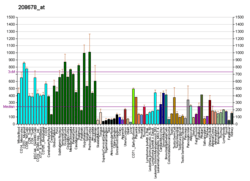ATP6V1E1
V-type proton ATPase subunit E 1 is an enzyme that in humans is encoded by the ATP6V1E1 gene.[5][6][7]
This gene encodes a component of vacuolar ATPase (V-ATPase), a multisubunit enzyme that mediates acidification of eukaryotic intracellular organelles. V-ATPase dependent organelle acidification is necessary for such intracellular processes as protein sorting, zymogen activation, receptor-mediated endocytosis, and synaptic vesicle proton gradient generation. V-ATPase is composed of a cytosolic V1 domain and a transmembrane V0 domain. The V1 domain consists of three A, three B, and two G subunits, as well as a C, D, E, F, and H subunit. The V1 domain contains the ATP catalytic site. This gene encodes alternate transcriptional splice variants, encoding different V1 domain E subunit isoforms. Pseudogenes for this gene have been found in the genome.[7]
References
- 1 2 3 GRCh38: Ensembl release 89: ENSG00000131100 - Ensembl, May 2017
- 1 2 3 GRCm38: Ensembl release 89: ENSMUSG00000019210 - Ensembl, May 2017
- ↑ "Human PubMed Reference:".
- ↑ "Mouse PubMed Reference:".
- ↑ Baud V, Mears AJ, Lamour V, Scamps C, Duncan AM, McDermid HE, Lipinski M (Jul 1994). "The E subunit of vacuolar H(+)-ATPase localizes close to the centromere on human chromosome 22". Hum Mol Genet. 3 (2): 335–9. doi:10.1093/hmg/3.2.335. PMID 8004105.
- ↑ van Hille B, Vanek M, Richener H, Green JR, Bilbe G (Jan 1994). "Cloning and tissue distribution of subunits C, D, and E of the human vacuolar H(+)-ATPase". Biochem Biophys Res Commun. 197 (1): 15–21. doi:10.1006/bbrc.1993.2434. PMID 8250920.
- 1 2 "Entrez Gene: ATP6V1E1 ATPase, H+ transporting, lysosomal 31kDa, V1 subunit E1".
External links
- Human ATP6V1E1 genome location and ATP6V1E1 gene details page in the UCSC Genome Browser.
Further reading
- Finbow ME, Harrison MA (1997). "The vacuolar H+-ATPase: a universal proton pump of eukaryotes". Biochem. J. 324. ( Pt 3): 697–712. doi:10.1042/bj3240697. PMC 1218484. PMID 9210392.
- Stevens TH, Forgac M (1998). "Structure, function and regulation of the vacuolar (H+)-ATPase". Annu. Rev. Cell Dev. Biol. 13 (1): 779–808. doi:10.1146/annurev.cellbio.13.1.779. PMID 9442887.
- Nelson N, Harvey WR (1999). "Vacuolar and plasma membrane proton-adenosinetriphosphatases". Physiol. Rev. 79 (2): 361–85. PMID 10221984.
- Forgac M (1999). "Structure and properties of the vacuolar (H+)-ATPases". J. Biol. Chem. 274 (19): 12951–4. doi:10.1074/jbc.274.19.12951. PMID 10224039.
- Kane PM (1999). "Introduction: V-ATPases 1992-1998". J. Bioenerg. Biomembr. 31 (1): 3–5. doi:10.1023/A:1001884227654. PMID 10340843.
- Wieczorek H, Brown D, Grinstein S, et al. (1999). "Animal plasma membrane energization by proton-motive V-ATPases". BioEssays. 21 (8): 637–48. doi:10.1002/(SICI)1521-1878(199908)21:8<637::AID-BIES3>3.0.CO;2-W. PMID 10440860.
- Nishi T, Forgac M (2002). "The vacuolar (H+)-ATPases--nature's most versatile proton pumps". Nat. Rev. Mol. Cell Biol. 3 (2): 94–103. doi:10.1038/nrm729. PMID 11836511.
- Kawasaki-Nishi S, Nishi T, Forgac M (2003). "Proton translocation driven by ATP hydrolysis in V-ATPases". FEBS Lett. 545 (1): 76–85. doi:10.1016/S0014-5793(03)00396-X. PMID 12788495.
- Morel N (2004). "Neurotransmitter release: the dark side of the vacuolar-H+ATPase". Biol. Cell. 95 (7): 453–7. doi:10.1016/S0248-4900(03)00075-3. PMID 14597263.
- Hemken P, Guo XL, Wang ZQ, et al. (1992). "Immunologic evidence that vacuolar H+ ATPases with heterogeneous forms of Mr = 31,000 subunit have different membrane distributions in mammalian kidney". J. Biol. Chem. 267 (14): 9948–57. PMID 1533641.
- Puech A, Saint-Jore B, Funke B, et al. (1998). "Comparative mapping of the human 22q11 chromosomal region and the orthologous region in mice reveals complex changes in gene organization". Proc. Natl. Acad. Sci. U.S.A. 94 (26): 14608–13. doi:10.1073/pnas.94.26.14608. PMC 25069. PMID 9405660.
- Breton S, Wiederhold T, Marshansky V, et al. (2000). "The B1 subunit of the H+ATPase is a PDZ domain-binding protein. Colocalization with NHE-RF in renal B-intercalated cells". J. Biol. Chem. 275 (24): 18219–24. doi:10.1074/jbc.M909857199. PMID 10748165.




